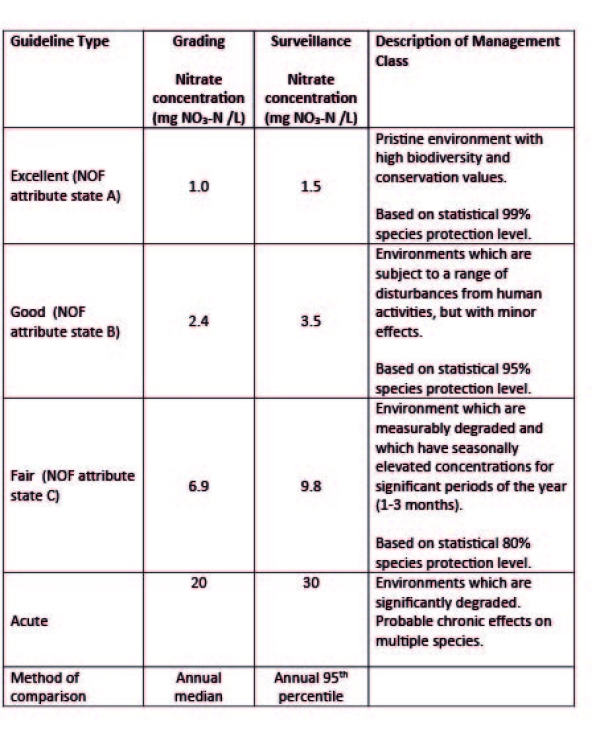The National Objectives Framework (NOF), includes nitrate toxicity values applicable to lakes and river environments. NIWA has undertaken a review to provide updated nitrate guidelines to contribute to the NOF standards for nitrate-nitrogen.
A review of the nitrate toxicity guidelines was undertaken in 2009 using the ANZECC guidelines derivation procedures . That revision indicated that freshwater species, particularly fish, were likely to be more sensitive than previously thought to long-term nitrate exposure. New guidelines were set indicating potential adverse effects at concentrations existing in many lowland New Zealand streams and rivers. The review also identified that though the database contained species resident in NZ there were no native species.
More recently, chronic sensitivity data for two native species (whitebait (inanga); and mayfly, Deleatidium) and early life stage tests for the New Zealand rainbow trout strain were established from long-term tests (20 – 40 day exposures).
Rainbow trout, the mayfly Deleatidium sp., and juvenile inanga were all markedly less sensitive than the most sensitive species, lake trout (by a factor of 16x, 13x and 7x respectively). These sensitivities correspond to: 57th, 48th and 29th percentiles of the nitrate toxicity database. Significantly, the chronic inanga sensitivity was found to be affected by water quality, with a 3.5-fold higher toxicity in low ionic strength water – an effect which is important for predicting the likelihood of adverse effects.
An updated nitrate guideline report was produced which incorporated the new native species data and recommended four fish and five invertebrate species as a priority to establish the sensitivity of native species. This updated database will form the basis of the interim ANZECC nitrate guideline, which is expected to be announced in 2014.
The proposed numeric nitrate guideline values for the NOF framework are based on the statistically-derived ‘no observed effect concentration’ (NOEC) and ‘threshold effect concentration’ (TEC) values for 22 species. The two-number guideline and management framework is based on, and is consistent with, the ANZECC (2000) guidelines risk-based methodology to provide various levels of ecosystem protection.
The compliance monitoring basis provides species protection for both average long-term exposure and seasonal maximum concentrations. The guidelines are summarised together with narrative descriptors in the attached table.
The terms 'Grading' and 'Surveillance' are derived from the compliance descriptors applied to microbiological standards. The Grading values are derived from the species NOEC values and recommended for compliance assessment based on the annual median concentrations. The Grading values are equivalent to trigger values as derived using the ANZECC (2000) procedure. The Surveillance values are derived from the species TEC values and recommended for compliance assessment based on the annual 95th percentile of monitoring data. The most sensitive guideline would establish the regulatory compliance value.
Environment Canada have recently updated their water quality guidelines for nitrate, and incorporated highly sensitive Lake Trout data as the most sensitive species. Additional supporting studies demonstrate that both fish and invertebrate species show a reduced sensitivity to nitrate as water hardness increases.
Though no hardness adjustment guidance was incorporated into the Environment Canada guidelines, there is sufficient data to indicate that higher water hardness will be expected to significantly reduce toxicity to aquatic species. In fresh water systems, the toxic effect of nitrate probably occurs by a similar mechanism to that causing methemoglobinemia (“blue-baby” syndrome) in humans. Thus it is important to understand the driving water quality factor(s) that affect nitrate toxicity in order to provide certainty around predicted levels of protection. The guidelines reported here should be considered conservative. The most sensitive species in the database used to derive the nitrate guidelines, is for long-term tests undertaken in very low hardness water – which would be expected to result in the highest nitrate toxicity.
Some information gaps were identified in undertaking the nitrate toxicity review. These included: (i) the adequacy of native fish and invertebrate data for surface waters; (ii) absence of hyporheic species; and (iii) toxicity modification in relation to water mineral content (measured by hardness).
Nine native species (4 fish and 5 invertebrate) were recommended as potential candidates for both acute and chronic testing. Priority species would include the common bully and eel elvas, which are both widespread and major inhabitants of lowland streams where nitrate concentrations tend to be highest. The invertebrate species include crustaceans (koura and amphipod), which tend to be highly sensitive to contaminants and the bivalve Sphaeriid, which is common in lowland streams and has been shown to be particularly sensitive to ammoniacal-N. NIWA is presently undertaking chronic testing with common bullies as a further stage in developing our understanding of nitrate toxicity risk to native species.
More information about the NOF.

